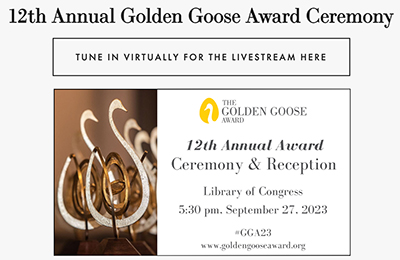Daniel Branton, Harvard’s Higgins Professor of Biology, Emeritus, and his collaborators David Deamer and Mark Akeson at the University of California, Santa Cruz, are among the 2023 Golden Goose Award winners for their invention and research developing Nanopore Sequencing.
“The Golden Goose Awards are awarded to research that sounded like too esoteric an idea at first but has since in fact had a major impact on society,” says Branton. First given out in 2012, they were an answer to the short-sightedness of the mockery of the “Golden Fleece” that suggested basic research had no benefit to greater society and should not be the beneficiaries of government grants.
“It’s wonderful to see Dan Branton recognized for inventing and developing this transformative technology,” says Rachelle Gaudet, Professor and Chair of Molecular and Cellular Biology. “I remember learning about the nanopore sequencing project as a postdoc in the Department in the late 1990s, and being fascinated by the concept and blown away by the early experiments that hinted that it may actually work someday. I appreciate that MCB, and Harvard more broadly, are communities that value and invest in basic research and bold ideas. We sometimes make the biggest leaps from the weird curiosity-driven corners of biology, something that Dan has demonstrated multiple times in his illustrious research career.”
Nanopore sequencing involves drawing many single strands of DNA through a two-nanometer diameter pore in an otherwise tightly sealed lipid membrane separating two small liquid filled containers. (Two nanometers is about 50,000 times smaller than the thickness of a piece of ordinary writing paper.) The liquid filled containers are wired with electrical contacts. As the DNA strand is drawn through the nanopore from the container on the first side of membrane to the container on the second side, the different nucleotide bases (known as A, C, G, T or U) trigger different electrical responses allowing researchers to identify the order or sequence of the bases. The technology provides real-time information on DNA sequence and is currently being used around the world in both large research laboratories and in field work situations.
The decades-long collaboration began in the early 1990s when Deamer and Branton began discussing their similar ideas for expediting the sequencing of DNA by drawing single nucleic acid strands through an interface. At the time, the only method available for sequencing DNA involved time consuming expensive biochemical maneuvers and electrophoresis in gels that required a controlled lab environment and heavy, costly equipment.
From the outset, the ideas underlying nanopore sequencing received pushback.
“The notion of sequencing nucleic acids by drawing single molecules of DNA or RNA through a nanopore was initially considered quite impossible by most people, including most of the expert scientists who reviewed our grant proposals at NIH.” says Branton. “In spite of the strong evidence we published in our 1996 PNAS paper, many readers initially doubted that we had in fact electrophoretically drawn a single polymer of nucleic acid through a nanopore. Furthermore, even after overcoming doubts about pulling DNA or RNA through a nanopore, a good scientist could foresee there would be many other problems to be overcome. Could all of these problems ever be solved? Indeed, it took us and our many bright, hardworking postdocs, students, and laboratory technicians some 25 years before the first crude sequence of a strand of DNA was obtained by nanopore sequencing.”
After years of work and publications, Harvard and UC Santa Cruz licensed patents to Oxford Nanopore Technologies (ONT). Within a few years ONT developed and bought to market the MinION, a small pocket-sized device that when plugged into a laptop computer becomes a complete sequencer. MinION’s portability makes it particularly well suited for important field work including the monitoring of the worldwide genetic evolution of Covid19, the Ebola virus in Africa, the microfauna at the top of an icebergs in the Arctic, or contaminants on the space station while soaring in space. And in the field or in the lab, nanopore sequencing produces direct, real-time sequence reads as soon as the sequencing process begins yielding up to 100 kb long reads or longer.
Branton is quick to note that while the researchers named as Golden Goose awardees developed the germ of the idea, its success depended on decades of hard work by students, postdocs, and research technician in his and his collaborators’ laboratories at UC Santa Cruz, as well as scientists and technicians in many different labs that pursued research related to the concept of nanopore sequencing.
For example, he recalls that Eric Brandin, who still works at Harvard, was the technician in his laboratory whose steady hands were responsible for performing the unusually difficult PCR sampling work which proved single DNA strands could actually be drawn through a nanopore, a proof that set the stage for much of the subsequent research that developed today’s nanopore sequencing .
“The Golden Goose award really is a celebration of Congress’s wisdom in supporting early-stage research,” says Branton “Such support is critically needed for the development of science in this country.”



